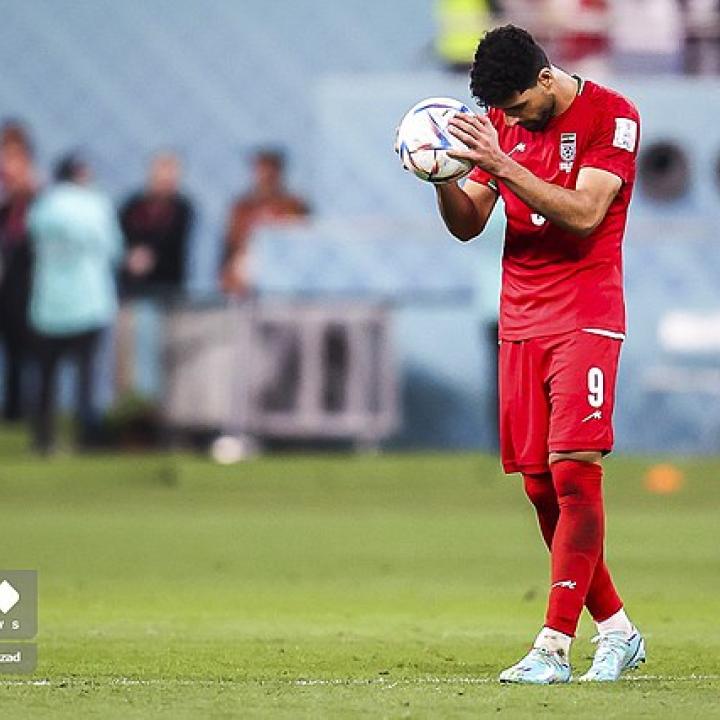
- Policy Analysis
- Fikra Forum
Iran Team’s Ambivalent Approach to Protests During the World Cup

Iran's loss at the World Cup coincides with controversy and tensions both back home and around the globe.
Iran finished their run at the World Cup in Qatar with a loss to the United States, ending an unsatisfactory performance there and following numerous controversies. Although the team had a higher chance to advance into the second round of the World Cup than in past years, the team’s performance represents a loss in the important battle of the public eye. Facing unprecedented dissatisfaction from its Iranian fan base, the team had been under severe public pressure to take a position regarding the recent wave of protests in Iran during their time in Qatar.
With Iranian celebrities adopting a more widespread engagement of the “woman, life, freedom” movement in Iran in recent months, the public’s expectations had grown that Iranian top-tier soccer players would use the international platform of the World Cup to convey similar messages to the world.
Inside Iran, Supreme Leader Ali Khamenei has remained as forceful and unapologetic as ever in the face of the current protests, but he is well aware of the movement’s deeper roots. In a recent speech, despite his bitter accounts about foreign involvement in the current “anarchy”, he acknowledged the failure of the system to maintain the bare minimum of economic growth under his watch in the last decade.
Without any signs that the state will back down, protestors are thirsty to see the fruition of their efforts moving into the third month of protests. This is especially true after more leaked files were circulated following a massive cyber-attack against Fars, the IRGC-ran news agency. Publicized this week, some of these files show the IRGC’s real perception and evaluation of the protests and the consequences of Iran’s presence in the world cup. Documents, including confidential bulletins shared with high-ranking commanders, show statistics about the approval ratings for the protests, public opinions about the hijab mandate, and reactions from the political elite. With the government showing signs of stress and concern, protestors might feel more energized and become more strategic now that they know the real perceptions of the state.
Given these tensions, the Iranian National team failed in attracting the massive support it used to enjoy during previous World Cup appearances. Before the first game even began, photographs circulated showing the team meeting with President Ibrahim Raisi, and what was meant to be a respectful gesture on behalf of the Iranian soccer players fueled the flames of agony and anger of the Iranian people in the streets.
Emphasized by media outlets such as Iran International and Manoto, this massive failure of team publicity could not even be remedied in the eyes of the people by the team’s subsequent refusal to sing the national anthem in their first game against England, or by their lack of emotional response to their victory against Wales. Tensions within the team’s fan base only increased after videos went viral showing a group of Iranians expressing happiness in response to Iran’s loss to England. In response, police forces inside Iran intentionally displayed a festive mood with Iranian flags in the streets following the team’s victory against Wales.
The politicization of Iran’s presence at the World Cup has also extended beyond the borders of Iran on a number of occasions. Case in point, the use of a pointedly incorrect Iranian flag—one lacking the emblem of the Islamic Republic of Iran—in a tweet by U.S. Soccer caused outrage in Iran and only raised tensions. This situation peaked at a pre-match press conference with the U.S. Team Captain, Tyler Adams, when Iranian reporters asked him about his stance on the wrong representation of the Iran flag and his own incorrect pronunciation of ‘Iran’. Iran’s Portuguese coach, Carlos Queiroz, was also not immune to politicization after he fell into an online argument with Jurgen Klinsmann—a former German soccer star and current FIFA official— when Klinsmann made racist comments about Iranian culture and Queiroz.
Nevertheless, the Iranian government seems to have benefited to some degree from its good relations with Qatar during the games. After Iran’s first game, Qatari security forces actually removed Iranian fans from the stadiums who had held protest signs. This week’s leak of a recording of a high ranking IRGC commander confirmed this claim. More specifically, a deputy commander of an IRGC branch, Qasim Qurayshi, revealed to an IRGC-backed journalist that Iran had expressed a demand for Qatar’s cooperation in favor of the Iranian government during the World Cup.
The Iran team’s difficulty at the world cup—both in terms of performance and reputation—comes at an already challenging time for the Iranian people. Struggling against an oppressive government that is unwilling to make any domestic or international compromises and facing the consequences of crippling U.S. sanctions, the people have long felt desperate and agitated. Of course, the last drop in the bucket of this agony was the death of Mahsa Amini. From day one of the protests, it was clear that “Woman, Life, Freedom” was just the surface of deeper issues and grievances in Iran. That these issues have spilled into the World Cup is unsurprising, but the team’s ambivalent position highlights the complicated relationship between national identity and sports, as well as the depth of issues inside Iran.


